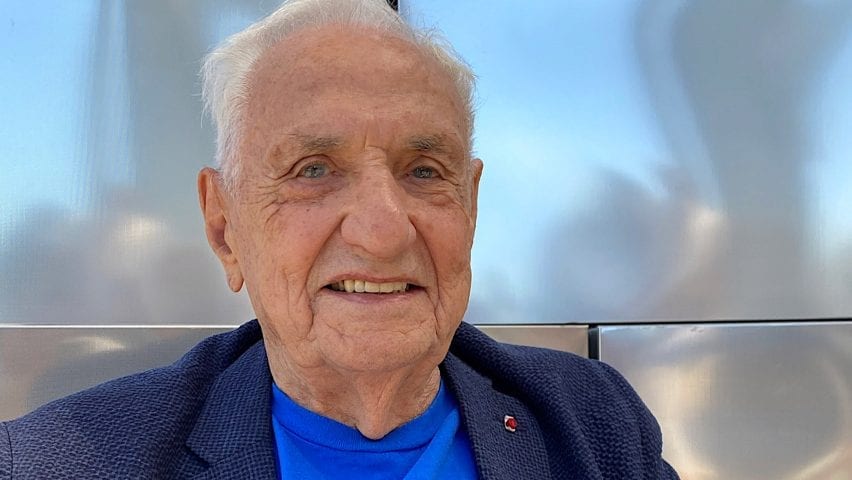
"I respond to every fucking detail of the time we're in" says Frank Gehry
Frank Gehry's new tower in Arles fits with both the ancient Roman city and today's environmental agenda, the architect claimed in an exclusive interview with Dezeen.
Speaking to Dezeen in Arles last week the Pritzker Prize-winner said The Tower, which has a steel-and-concrete frame and a glazed drum at its base, responds to current concerns about the carbon footprint of architecture.
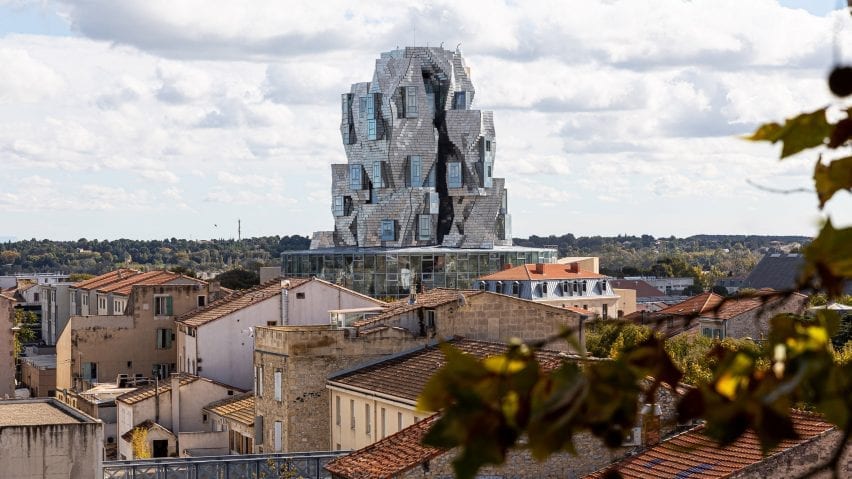
"We fit into it," said the Canadian-American architect. "But I can't explain it. I respond to every fucking detail of the time we're in with the people we live with, in this place," added the 92-year-old when asked about the building's environmental performance.
"So it's all taken into account as best I can," he continued.
"You know, I believe that's the most important thing to do," he added, gesturing to the face mask in his hands. "To live in the place and time you are in and what the issue is, you know, even with these fucking masks."
Sustainable elements include natural ventilation of the circular glazed podium while some of the building's energy comes from renewable sources. However, precise details of the building's embodied carbon have not been disclosed. The team did not submit the building for environmental certification under the French HQE programme.
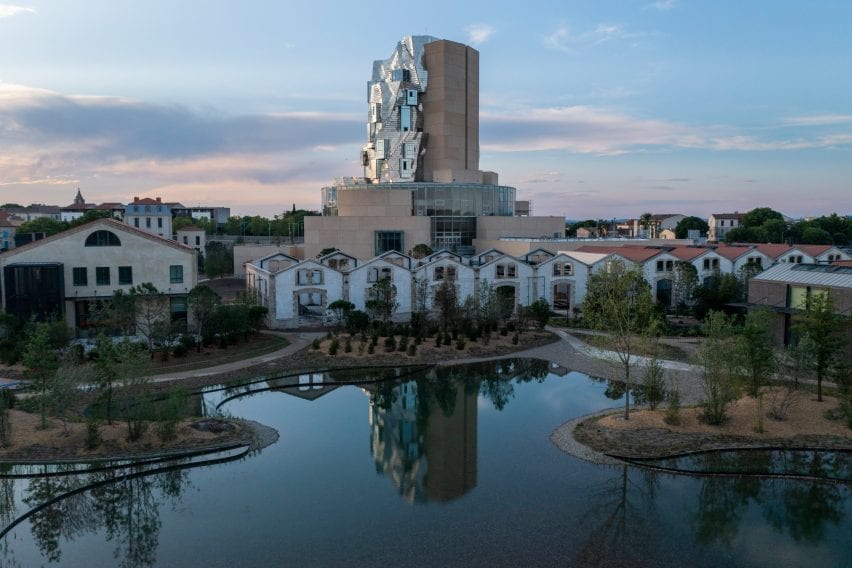
The Tower finally opened last week along with the rest of the vast Luma Arles cultural campus after a 14-year gestation period.
It serves as an entrance pavilion, lookout tower, exhibition-and-events space and beacon for the 27-acre campus commissioned by Maja Hoffmann, the art-collecting founder of Luma Foundation and the heiress to the Hoffmann-La Roche (now Roche) pharmaceutical fortune.
Founded in 2004, the philanthropic foundation "focuses on the direct relationships between art, culture, environmental issues, human rights, education and research".
The Luma name comes from Hoffmann's children, Lucas and Marina, echoing the way her father, the eminent environmentalist and World Wildlife Fund co-founder Luc Hoffmann, named his philanthropic conservation body MAVA Foundation after the initials of his children.
"I try not to repeat myself"
Gehry and Hoffmann, who is Swiss but grew up on her father's estate in the Camargue wetlands near Arles, first began discussing the building in 2006. This was long before sustainability topped the architectural agenda but when shiny icons were still very much the rage.
Their conversations began nine years after the opening of Gehry's titanium-clad Guggenheim Museum Bilbao and three years after the completion of his stainless-steel Walt Disney Concert Hall in Los Angeles.
But Gehry said that each project is a one-off rather than fitting into an evolution of his architectural approach.
"I try not to repeat myself," he said. "I just think about it at the time I'm doing it, the people I'm working with, like Maja, the community."
"So I don't think of it," he added. "I mean, naturally, there's like this historical lineage but it's just how I feel at this time in this place."
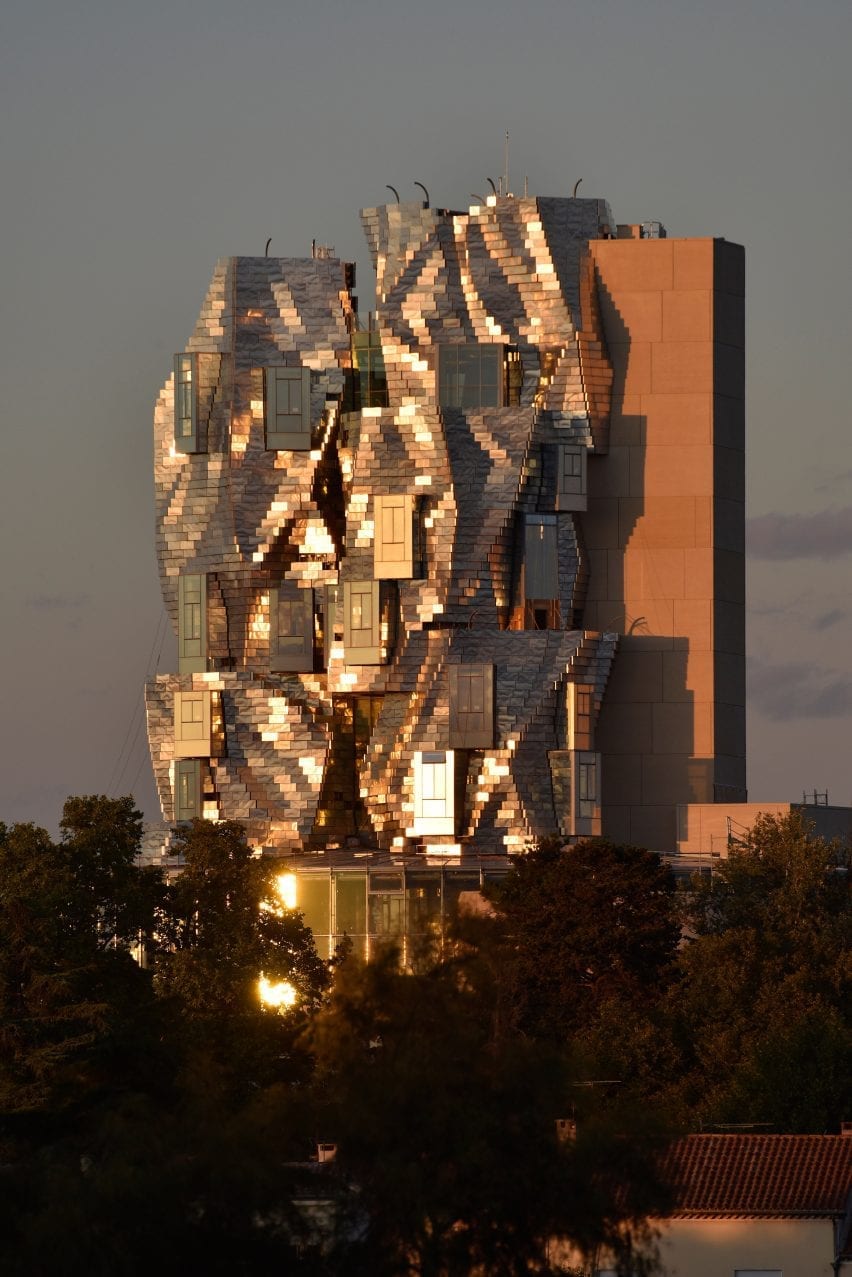
The 1997 Bilbao building introduced Gehry to the world, rebooted the city's economy and self-image, and fuelled the trend for iconic cultural buildings in cities hoping to replicate "the Bilbao effect".
Gehry sounds a little bemused by the term. "I don't really care about that, but it's nice that it changed the community," he said, as one of his team interjected, pointing out that he received death threats when the building was first proposed.
"When I went to Bilbao it was sad," he continued. "They were having a hard time economically. The kids growing up left Bilbao to go to college. They didn't stay there."
Gehry's Guggenheim is credited with turning around the fortunes of the post-industrial city in Spain's Basque country.
"I didn't mean to change the city"
"This has changed the economy," he said. "People come. I've been told they earn over eight billion Euros since the building opened. When you go there now it's friendly and open and happy."
"People are always telling me how I changed the city," he added. "I didn't mean to change the city, I just meant to be part of the city."
But Arles is no Bilbao. The UNESCO world heritage site is already a magnet for visitors coming for its spectacular Roman remains, its connection with artist Vincent van Gogh and Les Rencontres d'Arles, its world-renowned annual photography festival.
Located in a former SNCF railway engineering works on the edge of town, the Luma Arles campus adds another world-class attraction to the tiny city, which has a population of just 50,000.
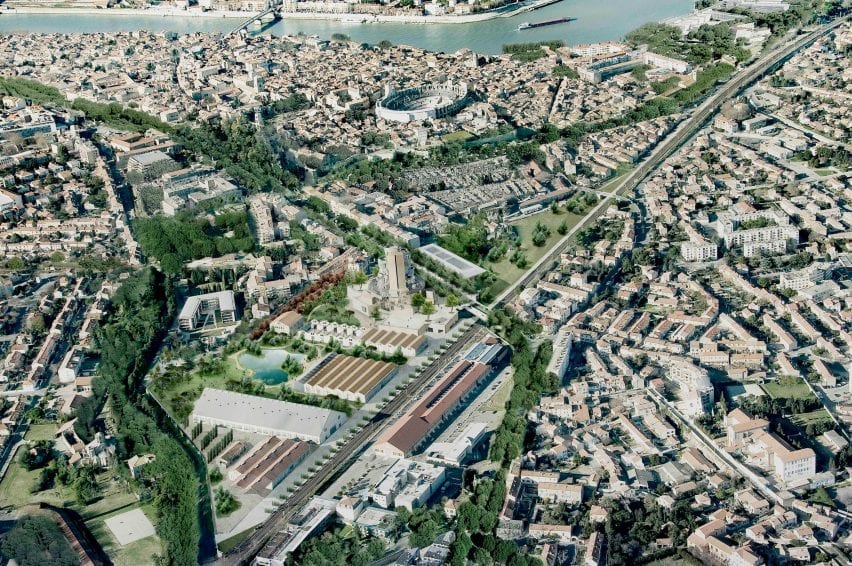
The railway sheds, repurposed into workshops, galleries and performance spaces by Selldorf Architects, are monumental in scale but these are eclipsed by Gehry's 56-metre-high tower. It is by far the tallest building in the area and dominates Avenue Victor Hugo, the main route into Arles, on a rise above the campus.
It towers over French architect Marc Barani's low-slung and discreetly minimalist École Nationale Supérieure de la Photographie, the French national photography school that sprang from the photo festival and opened in 2019, which lies directly across the road.
Arles, once a Roman provincial capital, sits on a low hill beside the river Rhône just before it enters the Camargue wetlands (which Hoffmann's father is credited with saving and where he established the Tour du Valat nature reserve) on its way to the Mediterranean, which is over 40 kilometres away.
"I don't antagonise. I don't try that"
The idea to build a tower came from Hoffmann, who expressed a desire to be able to "see the sea from the tower". But despite the requirement to build tall, Gehry said he did not intend to build a provocative structure.
"Well, I try to make it the scale of where we are," he said when reminded of the backlash from neighbours when he built his seminal 1978 home in Santa Monica. "And I try to make it user-friendly and not off-putting. So, you know, I don't make it black. And I don't antagonise. I don't try that. That's not my way."
The design process involved making dozens of scale models, many of which are exhibited in the vast exhibition space beneath the tower. These show how various approaches were explored including stacks of cubes, piles of oblongs and fabric-like forms.
However, none of the early models shows the twin concrete lift towers that break up the sculptural form at the rear of the tower.
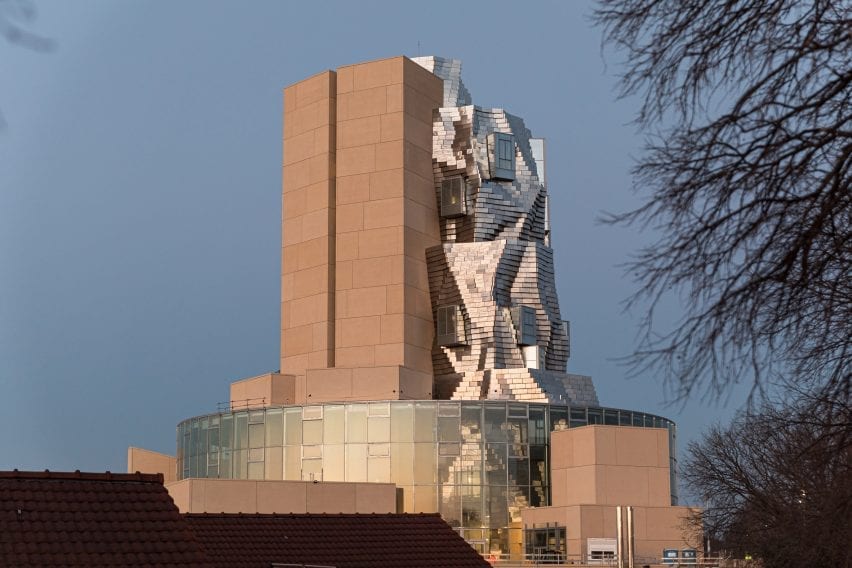
"There are over 100 models made of metal, wood… it was a long, long journey," said Gehry.
Over his career, Gehry has pioneered new approaches to creating architectural form, including scanning roughly made paper and card models and manipulating them in 3D software.
But this time, the models were made by his team. "I don't make them myself," he said. "I used to. It is a collaborative effort."
Gehry cites numerous local influences on the tower's form. Vincent van Gogh, the artist who lived in the city between 1888 and 1889 and painted many of his best-known works here, is one of them.
Gehry has compared the stainless-steel facade to the brushwork in Van Gogh's painting of Les Alpilles, a low range of mountains to the north-east of Arles that features distinctive limestone outcrops. He has also cited the nocturnal Starry Night painting as an influence.
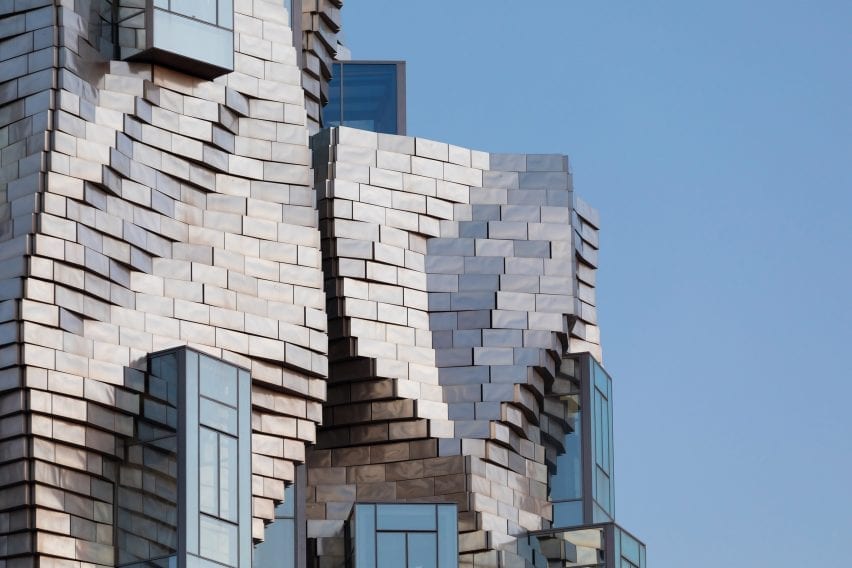
The Roman architecture of Arles is another influence, with its famous amphitheatre informing the glazed drum at the base of The Tower.
"Certainly the Roman amphitheatres were in my mind but I didn't want to copy them," he said at the press conference that marked the building's opening, when he joked that The Tower is "my first Roman building".
"But I thought that having a drum on the boulevard that became the foyer for the whole building was a simple way of inviting people from all sides, from all directions, as well as having a strong symbol, presence on the street."
The drum is naturally ventilated, one of a number of energy-saving features that were reverse-engineered into the project to make it more sustainable as the project rumbled on.
Others include a biodiesel plant and solar panels that provide some of the power for the campus, and the use of interior cladding made from local materials including agricultural waste, algae and salt to replace the originally specified gypsum drywall.
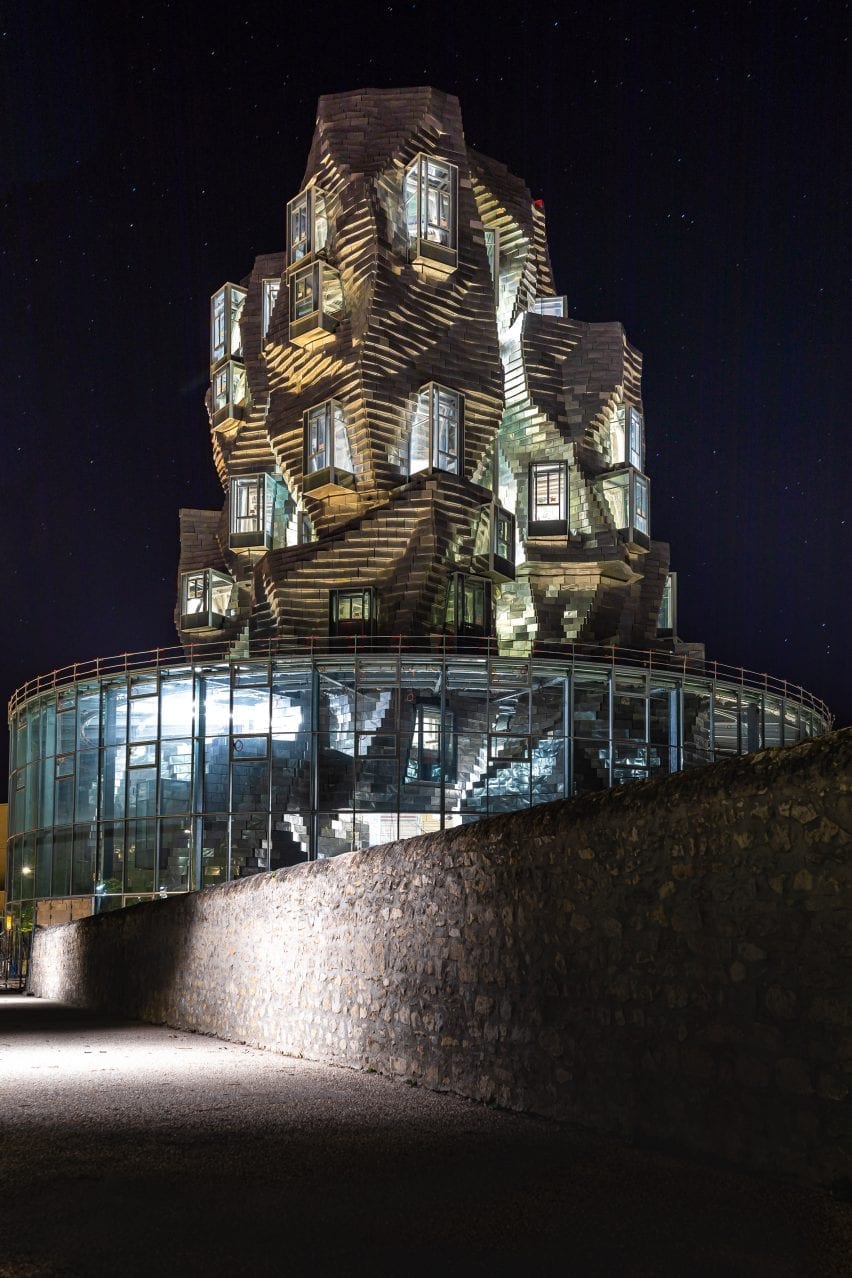
The latter interventions were carried out by designers at Atelier Luma, a design research lab located at the campus and headed by curator and educator Jan Boelen. There was apparently some tension over these interventions: when another journalist asked one of Gehry's team about the materials, he replied: "That wasn't us".
Gehry took further inspiration from Romanesque architecture, including landmarks he visited when studying architecture in Paris in the 1950s.
"I visited here," he said at the press conference. "I was living in Paris and studying Roman architecture. I was very moved by the architecture."
Speaking to Dezeen later, he rattled off a list of Roman-influenced medieval buildings around the country he recalls visiting in his student days, admiring their stonework.
"Autun, Vézelay, Tournus... I guess that's Romanesque. Yeah. I liked the stone blocks but I didn't want to repeat that."
Rather than stone, The Tower is faced in 11,000 hollow, non-structural blocks made of stainless steel sheets that have a textured pattern on them, allowing them to reflect the harsh Provençal light in a softer way.
"So we studied metal because it reflects the light. But I wondered if it could be soft and feel comfortable. Which it does."
Inevitably, the building has its detractors. Does criticism concern Gehry? Or does he prefer to give people a bit of time to get used to new buildings in their neighbourhood?
"It's more like the latter," he replied. "I don't presume anything. Really. I call it friendly or happy insecurity."
Photography is by Adrian Deweerdt.